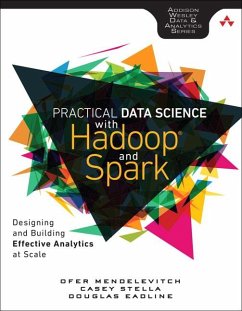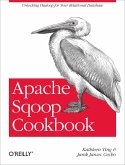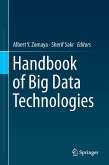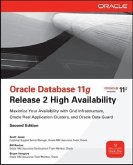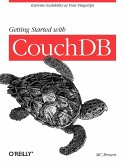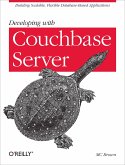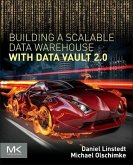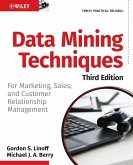Ofer Mendelevitch, Casey Stella, Douglas Eadline
Practical Data Science with Hadoop and Spark
Designing and Building Effective Analytics at Scale
Ofer Mendelevitch, Casey Stella, Douglas Eadline
Practical Data Science with Hadoop and Spark
Designing and Building Effective Analytics at Scale
- Broschiertes Buch
- Merkliste
- Auf die Merkliste
- Bewerten Bewerten
- Teilen
- Produkt teilen
- Produkterinnerung
- Produkterinnerung
This book provides a unique perspective on applying data science with Hadoop by explaining what data science with Hadoop is all about, its practical business applications, and then diving deep into the details and providing a hands-on tutorial and showcase of various use-cases from the real world. The authors bring together all the practical knowledge students will need to do real, useful data science with Hadoop.
Andere Kunden interessierten sich auch für
![Apache Sqoop Cookbook Apache Sqoop Cookbook]() Kathleen TingApache Sqoop Cookbook17,99 €
Kathleen TingApache Sqoop Cookbook17,99 €![Handbook of Big Data Technologies Handbook of Big Data Technologies]() Handbook of Big Data Technologies298,99 €
Handbook of Big Data Technologies298,99 €![Oracle Database 11g Release 2 High Availability: Maximize Your Availability with Grid Infrastructure, Rac and Data Guard Oracle Database 11g Release 2 High Availability: Maximize Your Availability with Grid Infrastructure, Rac and Data Guard]() Scott JesseOracle Database 11g Release 2 High Availability: Maximize Your Availability with Grid Infrastructure, Rac and Data Guard53,99 €
Scott JesseOracle Database 11g Release 2 High Availability: Maximize Your Availability with Grid Infrastructure, Rac and Data Guard53,99 €![Getting Started with Couchdb Getting Started with Couchdb]() Martin C. BrownGetting Started with Couchdb22,99 €
Martin C. BrownGetting Started with Couchdb22,99 €![Developing with Couchbase Server Developing with Couchbase Server]() M. C. BrownDeveloping with Couchbase Server22,99 €
M. C. BrownDeveloping with Couchbase Server22,99 €![Building a Scalable Data Warehouse with Data Vault 2.0 Building a Scalable Data Warehouse with Data Vault 2.0]() Daniel LinstedtBuilding a Scalable Data Warehouse with Data Vault 2.056,99 €
Daniel LinstedtBuilding a Scalable Data Warehouse with Data Vault 2.056,99 €![Data Mining Techniques Data Mining Techniques]() Gordon S. LinoffData Mining Techniques54,99 €
Gordon S. LinoffData Mining Techniques54,99 €-
-
-
This book provides a unique perspective on applying data science with Hadoop by explaining what data science with Hadoop is all about, its practical business applications, and then diving deep into the details and providing a hands-on tutorial and showcase of various use-cases from the real world. The authors bring together all the practical knowledge students will need to do real, useful data science with Hadoop.
Hinweis: Dieser Artikel kann nur an eine deutsche Lieferadresse ausgeliefert werden.
Hinweis: Dieser Artikel kann nur an eine deutsche Lieferadresse ausgeliefert werden.
Produktdetails
- Produktdetails
- Verlag: Addison-Wesley Longman, Amsterdam / PEV
- Seitenzahl: 256
- Erscheinungstermin: 12. Dezember 2016
- Englisch
- Abmessung: 231mm x 179mm x 17mm
- Gewicht: 410g
- ISBN-13: 9780134024141
- ISBN-10: 0134024141
- Artikelnr.: 42372311
- Herstellerkennzeichnung
- Libri GmbH
- Europaallee 1
- 36244 Bad Hersfeld
- gpsr@libri.de
- Verlag: Addison-Wesley Longman, Amsterdam / PEV
- Seitenzahl: 256
- Erscheinungstermin: 12. Dezember 2016
- Englisch
- Abmessung: 231mm x 179mm x 17mm
- Gewicht: 410g
- ISBN-13: 9780134024141
- ISBN-10: 0134024141
- Artikelnr.: 42372311
- Herstellerkennzeichnung
- Libri GmbH
- Europaallee 1
- 36244 Bad Hersfeld
- gpsr@libri.de
Ofer Mendelevitch is Vice President of Data Science at Lendup, where he is responsible for Lendup’s machine learning and advanced analytics group. Prior to joining Lendup, Ofer was Director of Data Science at Hortonworks, where he was responsible for helping Hortonwork’s customers apply Data Science with Hadoop and Spark to big data across various industries including healthcare, finance, retail and others. Before Hortonworks, Ofer served as Entrepreneur in Residence at XSeed Capital, VP of Engineering at Nor1, and Director of Engineering at Yahoo!. Casey Stella is a Principal Software Engineer focusing on Data Science at Hortonworks, which provides an open source Hadoop distribution. Casey’s primary responsibility is leading the analytics/data science team for the Apache Metron (Incubating) Project, an open source cybersecurity project. Prior to Hortonworks, Casey was an architect at Explorys, which was a medical informatics startup spun out of the Cleveland Clinic. In the more distant past, Casey served as a developer at Oracle, Research Geophysicist at ION Geophysical and as a poor graduate student in Mathematics at Texas A&M. Douglas Eadline, PhD, began his career as analytical chemist with an interest in computer methods. Starting with the first Beowulf how-to document, Doug has written hundreds of articles, white papers, and instructional documents covering many aspects of HPC and Hadoop computing. Prior to starting and editing the popular ClusterMonkey.net website in 2005, he served as editor¿in¿chief for ClusterWorld Magazine and was senior HPC editor for Linux Magazine. He has practical hands-on experience in many aspects of HPC and Apache Hadoop, including hardware and software design, benchmarking, storage, GPU, cloud computing, and parallel computing. Currently, he is a writer and consultant to the HPC/analytics industry and leader of the Limulus Personal Cluster Project (http://limulus.basement-supercomputing.com). He is author of the Apache Hadoop® Fundamentals LiveLessons and Apache Hadoop® YARN Fundamentals LiveLessons videos from Pearson, and is book co-author of Apache Hadoop® YARN: Moving beyond MapReduce and Batch Processing with Apache Hadoop 2 and author of Hadoop® 2 Quick Start Guide: Learn the Essentials of Big Data Computing in the Apache Hadoop 2 Ecosystem, also from Addison-Wesley, and is author of High Performance Computing for Dummies.
Foreword xiii
Preface xv
Acknowledgments xxi
About the Authors xxiii
Part I: Data Science with Hadoop—An Overview 1
Chapter 1: Introduction to Data Science 3
What Is Data Science? 3
Example: Search Advertising 4
A Bit of Data Science History 5
Becoming a Data Scientist 8
Building a Data Science Team 12
The Data Science Project Life Cycle 13
Managing a Data Science Project 18
Summary 18
Chapter 2: Use Cases for Data Science 19
Big Data—A Driver of Change 19
Business Use Cases 21
Summary 29
Chapter 3: Hadoop and Data Science 31
What Is Hadoop? 31
Hadoop’s Evolution 37
Hadoop Tools for Data Science 38
Why Hadoop Is Useful to Data Scientists 46
Summary 51
Part II: Preparing and Visualizing Data with Hadoop 53
Chapter 4: Getting Data into Hadoop 55
Hadoop as a Data Lake 56
The Hadoop Distributed File System (HDFS) 58
Direct File Transfer to Hadoop HDFS 58
Importing Data from Files into Hive Tables 59
Importing Data into Hive Tables Using Spark 62
Using Apache Sqoop to Acquire Relational Data 65
Using Apache Flume to Acquire Data Streams 74
Manage Hadoop Work and Data Flows with Apache
Oozie 79
Apache Falcon 81
What’s Next in Data Ingestion? 82
Summary 82
Chapter 5: Data Munging with Hadoop 85
Why Hadoop for Data Munging? 86
Data Quality 86
The Feature Matrix 93
Summary 106
Chapter 6: Exploring and Visualizing Data 107
Why Visualize Data? 107
Creating Visualizations 112
Using Visualization for Data Science 121
Popular Visualization Tools 121
Visualizing Big Data with Hadoop 123
Summary 124
Part III: Applying Data Modeling with Hadoop 125
Chapter 7: Machine Learning with Hadoop 127
Overview of Machine Learning 127
Terminology 128
Task Types in Machine Learning 129
Big Data and Machine Learning 130
Tools for Machine Learning 131
The Future of Machine Learning and Artificial Intelligence 132
Summary 132
Chapter 8: Predictive Modeling 133
Overview of Predictive Modeling 133
Classification Versus Regression 134
Evaluating Predictive Models 136
Supervised Learning Algorithms 140
Building Big Data Predictive Model Solutions 141
Example: Sentiment Analysis 145
Summary 150
Chapter 9: Clustering 151
Overview of Clustering 151
Uses of Clustering 152
Designing a Similarity Measure 153
Clustering Algorithms 154
Example: Clustering Algorithms 155
Evaluating the Clusters and Choosing the Number of Clusters 157
Building Big Data Clustering Solutions 158
Example: Topic Modeling with Latent Dirichlet Allocation 160
Summary 163
Chapter 10: Anomaly Detection with Hadoop 165
Overview 165
Uses of Anomaly Detection 166
Types of Anomalies in Data 166
Approaches to Anomaly Detection 167
Tuning Anomaly Detection Systems 170
Building a Big Data Anomaly Detection Solution with Hadoop 171
Example: Detecting Network Intrusions 172
Summary 179
Chapter 11: Natural Language Processing 181
Natural Language Processing 181
Tooling for NLP in Hadoop 184
Textual Representations 187
Sentiment Analysis Example 189
Summary 193
Chapter 12: Data Science with Hadoop—The Next Frontier 195
Automated Data Discovery 195
Deep Learning 197
Summary 199
Appendix A: Book Web Page and Code Download 201
Appendix B: HDFS Quick Start 203
Quick Command Dereference 204
Appendix C: Additional Background on Data Science and Apache Hadoop and
Spark 209
General Hadoop/Spark Information 209
Hadoop/Spark Installation Recipes 210
HDFS 210
MapReduce 211
Spark 211
Essential Tools 211
Machine Learning 212
Index 213
Preface xv
Acknowledgments xxi
About the Authors xxiii
Part I: Data Science with Hadoop—An Overview 1
Chapter 1: Introduction to Data Science 3
What Is Data Science? 3
Example: Search Advertising 4
A Bit of Data Science History 5
Becoming a Data Scientist 8
Building a Data Science Team 12
The Data Science Project Life Cycle 13
Managing a Data Science Project 18
Summary 18
Chapter 2: Use Cases for Data Science 19
Big Data—A Driver of Change 19
Business Use Cases 21
Summary 29
Chapter 3: Hadoop and Data Science 31
What Is Hadoop? 31
Hadoop’s Evolution 37
Hadoop Tools for Data Science 38
Why Hadoop Is Useful to Data Scientists 46
Summary 51
Part II: Preparing and Visualizing Data with Hadoop 53
Chapter 4: Getting Data into Hadoop 55
Hadoop as a Data Lake 56
The Hadoop Distributed File System (HDFS) 58
Direct File Transfer to Hadoop HDFS 58
Importing Data from Files into Hive Tables 59
Importing Data into Hive Tables Using Spark 62
Using Apache Sqoop to Acquire Relational Data 65
Using Apache Flume to Acquire Data Streams 74
Manage Hadoop Work and Data Flows with Apache
Oozie 79
Apache Falcon 81
What’s Next in Data Ingestion? 82
Summary 82
Chapter 5: Data Munging with Hadoop 85
Why Hadoop for Data Munging? 86
Data Quality 86
The Feature Matrix 93
Summary 106
Chapter 6: Exploring and Visualizing Data 107
Why Visualize Data? 107
Creating Visualizations 112
Using Visualization for Data Science 121
Popular Visualization Tools 121
Visualizing Big Data with Hadoop 123
Summary 124
Part III: Applying Data Modeling with Hadoop 125
Chapter 7: Machine Learning with Hadoop 127
Overview of Machine Learning 127
Terminology 128
Task Types in Machine Learning 129
Big Data and Machine Learning 130
Tools for Machine Learning 131
The Future of Machine Learning and Artificial Intelligence 132
Summary 132
Chapter 8: Predictive Modeling 133
Overview of Predictive Modeling 133
Classification Versus Regression 134
Evaluating Predictive Models 136
Supervised Learning Algorithms 140
Building Big Data Predictive Model Solutions 141
Example: Sentiment Analysis 145
Summary 150
Chapter 9: Clustering 151
Overview of Clustering 151
Uses of Clustering 152
Designing a Similarity Measure 153
Clustering Algorithms 154
Example: Clustering Algorithms 155
Evaluating the Clusters and Choosing the Number of Clusters 157
Building Big Data Clustering Solutions 158
Example: Topic Modeling with Latent Dirichlet Allocation 160
Summary 163
Chapter 10: Anomaly Detection with Hadoop 165
Overview 165
Uses of Anomaly Detection 166
Types of Anomalies in Data 166
Approaches to Anomaly Detection 167
Tuning Anomaly Detection Systems 170
Building a Big Data Anomaly Detection Solution with Hadoop 171
Example: Detecting Network Intrusions 172
Summary 179
Chapter 11: Natural Language Processing 181
Natural Language Processing 181
Tooling for NLP in Hadoop 184
Textual Representations 187
Sentiment Analysis Example 189
Summary 193
Chapter 12: Data Science with Hadoop—The Next Frontier 195
Automated Data Discovery 195
Deep Learning 197
Summary 199
Appendix A: Book Web Page and Code Download 201
Appendix B: HDFS Quick Start 203
Quick Command Dereference 204
Appendix C: Additional Background on Data Science and Apache Hadoop and
Spark 209
General Hadoop/Spark Information 209
Hadoop/Spark Installation Recipes 210
HDFS 210
MapReduce 211
Spark 211
Essential Tools 211
Machine Learning 212
Index 213
Foreword xiii
Preface xv
Acknowledgments xxi
About the Authors xxiii
Part I: Data Science with Hadoop—An Overview 1
Chapter 1: Introduction to Data Science 3
What Is Data Science? 3
Example: Search Advertising 4
A Bit of Data Science History 5
Becoming a Data Scientist 8
Building a Data Science Team 12
The Data Science Project Life Cycle 13
Managing a Data Science Project 18
Summary 18
Chapter 2: Use Cases for Data Science 19
Big Data—A Driver of Change 19
Business Use Cases 21
Summary 29
Chapter 3: Hadoop and Data Science 31
What Is Hadoop? 31
Hadoop’s Evolution 37
Hadoop Tools for Data Science 38
Why Hadoop Is Useful to Data Scientists 46
Summary 51
Part II: Preparing and Visualizing Data with Hadoop 53
Chapter 4: Getting Data into Hadoop 55
Hadoop as a Data Lake 56
The Hadoop Distributed File System (HDFS) 58
Direct File Transfer to Hadoop HDFS 58
Importing Data from Files into Hive Tables 59
Importing Data into Hive Tables Using Spark 62
Using Apache Sqoop to Acquire Relational Data 65
Using Apache Flume to Acquire Data Streams 74
Manage Hadoop Work and Data Flows with Apache
Oozie 79
Apache Falcon 81
What’s Next in Data Ingestion? 82
Summary 82
Chapter 5: Data Munging with Hadoop 85
Why Hadoop for Data Munging? 86
Data Quality 86
The Feature Matrix 93
Summary 106
Chapter 6: Exploring and Visualizing Data 107
Why Visualize Data? 107
Creating Visualizations 112
Using Visualization for Data Science 121
Popular Visualization Tools 121
Visualizing Big Data with Hadoop 123
Summary 124
Part III: Applying Data Modeling with Hadoop 125
Chapter 7: Machine Learning with Hadoop 127
Overview of Machine Learning 127
Terminology 128
Task Types in Machine Learning 129
Big Data and Machine Learning 130
Tools for Machine Learning 131
The Future of Machine Learning and Artificial Intelligence 132
Summary 132
Chapter 8: Predictive Modeling 133
Overview of Predictive Modeling 133
Classification Versus Regression 134
Evaluating Predictive Models 136
Supervised Learning Algorithms 140
Building Big Data Predictive Model Solutions 141
Example: Sentiment Analysis 145
Summary 150
Chapter 9: Clustering 151
Overview of Clustering 151
Uses of Clustering 152
Designing a Similarity Measure 153
Clustering Algorithms 154
Example: Clustering Algorithms 155
Evaluating the Clusters and Choosing the Number of Clusters 157
Building Big Data Clustering Solutions 158
Example: Topic Modeling with Latent Dirichlet Allocation 160
Summary 163
Chapter 10: Anomaly Detection with Hadoop 165
Overview 165
Uses of Anomaly Detection 166
Types of Anomalies in Data 166
Approaches to Anomaly Detection 167
Tuning Anomaly Detection Systems 170
Building a Big Data Anomaly Detection Solution with Hadoop 171
Example: Detecting Network Intrusions 172
Summary 179
Chapter 11: Natural Language Processing 181
Natural Language Processing 181
Tooling for NLP in Hadoop 184
Textual Representations 187
Sentiment Analysis Example 189
Summary 193
Chapter 12: Data Science with Hadoop—The Next Frontier 195
Automated Data Discovery 195
Deep Learning 197
Summary 199
Appendix A: Book Web Page and Code Download 201
Appendix B: HDFS Quick Start 203
Quick Command Dereference 204
Appendix C: Additional Background on Data Science and Apache Hadoop and
Spark 209
General Hadoop/Spark Information 209
Hadoop/Spark Installation Recipes 210
HDFS 210
MapReduce 211
Spark 211
Essential Tools 211
Machine Learning 212
Index 213
Preface xv
Acknowledgments xxi
About the Authors xxiii
Part I: Data Science with Hadoop—An Overview 1
Chapter 1: Introduction to Data Science 3
What Is Data Science? 3
Example: Search Advertising 4
A Bit of Data Science History 5
Becoming a Data Scientist 8
Building a Data Science Team 12
The Data Science Project Life Cycle 13
Managing a Data Science Project 18
Summary 18
Chapter 2: Use Cases for Data Science 19
Big Data—A Driver of Change 19
Business Use Cases 21
Summary 29
Chapter 3: Hadoop and Data Science 31
What Is Hadoop? 31
Hadoop’s Evolution 37
Hadoop Tools for Data Science 38
Why Hadoop Is Useful to Data Scientists 46
Summary 51
Part II: Preparing and Visualizing Data with Hadoop 53
Chapter 4: Getting Data into Hadoop 55
Hadoop as a Data Lake 56
The Hadoop Distributed File System (HDFS) 58
Direct File Transfer to Hadoop HDFS 58
Importing Data from Files into Hive Tables 59
Importing Data into Hive Tables Using Spark 62
Using Apache Sqoop to Acquire Relational Data 65
Using Apache Flume to Acquire Data Streams 74
Manage Hadoop Work and Data Flows with Apache
Oozie 79
Apache Falcon 81
What’s Next in Data Ingestion? 82
Summary 82
Chapter 5: Data Munging with Hadoop 85
Why Hadoop for Data Munging? 86
Data Quality 86
The Feature Matrix 93
Summary 106
Chapter 6: Exploring and Visualizing Data 107
Why Visualize Data? 107
Creating Visualizations 112
Using Visualization for Data Science 121
Popular Visualization Tools 121
Visualizing Big Data with Hadoop 123
Summary 124
Part III: Applying Data Modeling with Hadoop 125
Chapter 7: Machine Learning with Hadoop 127
Overview of Machine Learning 127
Terminology 128
Task Types in Machine Learning 129
Big Data and Machine Learning 130
Tools for Machine Learning 131
The Future of Machine Learning and Artificial Intelligence 132
Summary 132
Chapter 8: Predictive Modeling 133
Overview of Predictive Modeling 133
Classification Versus Regression 134
Evaluating Predictive Models 136
Supervised Learning Algorithms 140
Building Big Data Predictive Model Solutions 141
Example: Sentiment Analysis 145
Summary 150
Chapter 9: Clustering 151
Overview of Clustering 151
Uses of Clustering 152
Designing a Similarity Measure 153
Clustering Algorithms 154
Example: Clustering Algorithms 155
Evaluating the Clusters and Choosing the Number of Clusters 157
Building Big Data Clustering Solutions 158
Example: Topic Modeling with Latent Dirichlet Allocation 160
Summary 163
Chapter 10: Anomaly Detection with Hadoop 165
Overview 165
Uses of Anomaly Detection 166
Types of Anomalies in Data 166
Approaches to Anomaly Detection 167
Tuning Anomaly Detection Systems 170
Building a Big Data Anomaly Detection Solution with Hadoop 171
Example: Detecting Network Intrusions 172
Summary 179
Chapter 11: Natural Language Processing 181
Natural Language Processing 181
Tooling for NLP in Hadoop 184
Textual Representations 187
Sentiment Analysis Example 189
Summary 193
Chapter 12: Data Science with Hadoop—The Next Frontier 195
Automated Data Discovery 195
Deep Learning 197
Summary 199
Appendix A: Book Web Page and Code Download 201
Appendix B: HDFS Quick Start 203
Quick Command Dereference 204
Appendix C: Additional Background on Data Science and Apache Hadoop and
Spark 209
General Hadoop/Spark Information 209
Hadoop/Spark Installation Recipes 210
HDFS 210
MapReduce 211
Spark 211
Essential Tools 211
Machine Learning 212
Index 213

